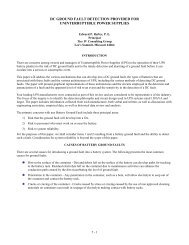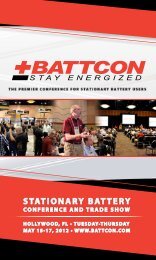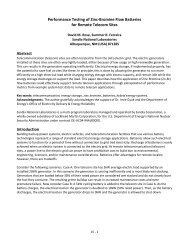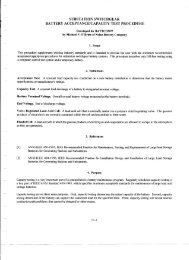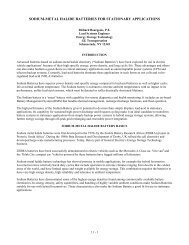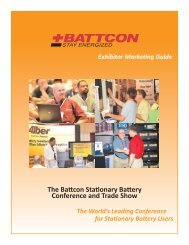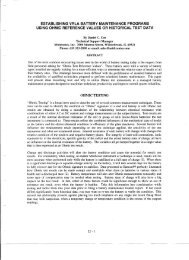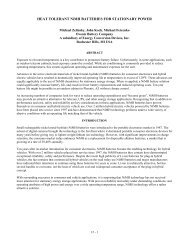Monobloc Batteries: High Temperature, Life and Catalysts - Battcon ...
Monobloc Batteries: High Temperature, Life and Catalysts - Battcon ...
Monobloc Batteries: High Temperature, Life and Catalysts - Battcon ...
You also want an ePaper? Increase the reach of your titles
YUMPU automatically turns print PDFs into web optimized ePapers that Google loves.
For flooded stationary lead acid batteries, the design life of the cell is based on the corrosion of the positive grid material. The<br />
stationary flooded battery design has been refined over many years so that the weakest link is the positive plate. The other<br />
factors that used to cause these batteries to fail have been improved so that the positive plate is the first to go. Much of the<br />
reason that flooded lead acid cells last so long today (generally around 20 years) is that a huge amount of effort went into<br />
selecting <strong>and</strong> designing a positive grid that minimizes corrosion. Pure lead <strong>and</strong> thick grid elements were selected to obtain the<br />
20-year design life. The test methods that were developed to prove out the design <strong>and</strong> to show that corrosion had been<br />
minimized were also used to determine the life expectations of the products themselves. This worked very well in flooded<br />
lead acid cells as history has proven. The life of these batteries could accurately be predicted by the corrosion rate of the<br />
positive grid so battery manufacturers could determine the life without having to wait 20 years. End users could reasonably<br />
expect their flooded stationary lead acid cells to last as long as they were being told because these cells were being used in an<br />
environment that matched the conditions tested for; namely life at room temperature in a controlled central office facility.<br />
<strong>Life</strong> was good.<br />
The problem developed when this life prediction <strong>and</strong> testing was exp<strong>and</strong>ed to VRLA cells. VRLA cells do not behave like<br />
flooded stationary lead acid cells <strong>and</strong> the design has not had as much time to mature. While positive grid corrosion is a big<br />
concern there are other things that must be considered when the electrolyte is minimized. The health of the negative plate<br />
must also be considered, but this was not known at first. In the early days of VRLA technology the same life prediction<br />
equations were used because the thinking at the time was that the limiting life factor would be the positive grid as it was in<br />
flooded stationary lead acid. Time has proven that this is not entirely correct. There is more than one factor at work in VRLA<br />
cells to reduce the life of the battery, especially in high temperature applications. Many of the failure modes that have<br />
impacted VRLA batteries in the past have been greatly reduced by improvements in the design by battery manufacturers.<br />
These include: Post seal leaks, vent design, plate compression, alloy modifications, lead purity, <strong>and</strong> others. The goal of the<br />
industry is to maximize the life span of the positive plate <strong>and</strong> make sure no other cause causes battery failure prior to that<br />
point in time.<br />
Unlike 2-volt VRLA cells, 12-volt monobloc VRLA batteries have shorter life expectations. The design life for 12-volt<br />
monobloc batteries is generally 5 to 10 years depending on the design of the battery <strong>and</strong> the price paid for the product. The<br />
shorter projected life is primarily due to the fact that these batteries have thinner positive plates. The thinner plates allow<br />
these batteries to take up less room <strong>and</strong> cost less for the same capacity as a thicker plate design would. Essentially the user<br />
gets higher energy density <strong>and</strong> higher capacity at a lower cost, but at the expense of a shorter life of the battery. In room<br />
temperature applications, the actual life is acceptable for 12-volt monoblocs. The problem arises when these batteries are<br />
placed in high temperature applications. In these instances there is a large mismatch between the design life <strong>and</strong> the actual<br />
life. In a previous <strong>Battcon</strong> paper it was found that at high temperatures the primary failure mode of 12-volt monobloc VRLA<br />
batteries at 65°C was positive plate corrosion <strong>and</strong> growth <strong>and</strong> that water loss was also seen. 12 Another paper found that the<br />
primary failure mode was dry out. 13 It is clear that sustainability of the 12-volt monobloc VRLA design is at risk in high<br />
temperature applications. The costs of replacing these batteries at remote, outside plant applications every year quickly<br />
surpasses the cost of the battery product itself <strong>and</strong> makes the economic viability of using this product in these high<br />
temperature applications questionable.<br />
TEMPERATURE IMPACT ON LIFE<br />
<strong>Batteries</strong>, unlike other components in the power plant, degrade over time. Unlike mechanical components that wear out, there<br />
is no visible sign of the degradation. Also the process is always progressing <strong>and</strong> can’t be stopped. But there are many factors<br />
that can affect the rate of the degradation. There are design factors such as the purity of the alloys, the thickness of the plates,<br />
etc. There are also environmental or application specific factors that have an impact. The two sets of factors are inter-related,<br />
because the design must be done taking into account the environmental factors that are likely to be encountered. <strong>Temperature</strong><br />
is perhaps the environmental variable that has the biggest impact on the actual life of the battery. This factor has become a<br />
much bigger issue because of the increase in distributed requirements for battery power. There are more applications for<br />
batteries in the outside plant environments where there is no air conditioning. In the past flooded batteries were tested at high<br />
temperatures to accelerate the testing with no expectation that batteries would actually be operated at those temperatures.<br />
Now, the elevated temperatures actually represent the operating environment the battery will see. How long a battery will last<br />
in these high temperature environments is becoming a major concern for end users.<br />
15 - 2



